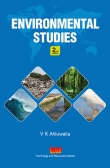Environmental Chemistry : Principles and Recent Advances
- Author(s): P Padmaja Sudhakar and V J Koshy
- Size: 180 mm x 240 mm
- Pages: 834
- Binding: Paperback
- Publishing Status: Forthcoming
- Language: English
- ISBN: 9788179935224
- Cover Price:
Rs.650.00 / US $46.00
- Special Price: Rs. 585.00 / US $41.00
Book Details
Chemistry plays a vital role in environmental protection and improvement. Over the years, environmental chemistry has emerged as a strong and dynamic science that has made enormous contributions to understanding the environment and the chemical and biochemical processes that occur in it. Environmental Chemistry: principles and recent advances provides a holistic view of the chemical processes in all segments of the environment.
It discusses the various pollutants present in the atmosphere, including persistent and bioaccumulative chemicals, pesticides, nanoparticles, and chiral pollutants. Advances in treatment techniques and analysis and monitoring of pollutants are the other topics covered in detail. A chapter has been dedicated for a omprehensive discussion on green chemistry. The book also talks about the Best Available Techniques (BAT) adapted by industries for Preventing and Controlling Pollution and also provides information on the application of analytical techniques, such as GC, LC, IR, and MS for analysing and measuring aqueous, solid and atmospheric samples and for monitoring environmental pollutants.
Key Features
- Comprehensive coverage of recent remediation technologies
- Inclusion of application of nanomaterials—their environmental effects and measurement techniques
- Focus on green chemistry with respect to environmental processes
- Significant emphasis on carbon sequestration and carbon credits
- Specific focus on major environmental disasters, including the Fukiyama Daiichi nuclear disaster
Target Audience
-
Graduate and Postgraduate students, Researchers, and Academicians of Chemistry, Environmental Science, Chemical Engineering, Pharmacists
Table of Contents
Preface
1. Basic Concept and Scope
1.1 Introduction
1.2 Definition and Explanation of Various Terms
1.3 Principles and Cyclic Pathways in the Environment
2. Fundamentals of Chemical Thermodynamics
2.1 Introduction
2.2 The First Law of Thermodynamics
2.3 Second Law of Thermodynamics
2.4 Chemical Equilibrium
2.5 Lipid–water Partitioning
2.6 Particle–water Partitioning
2.7 Air–water Partitioning
2.8 Radionuclides
2.9 Natural Radioactive Decay Series
2.10 Hydrocarbons
2.11 Conclusion
3. Atmospheric Chemistry
3.1 Introduction
3.2 Temperature Inversions
3.3 Reactions in the Atmosphere
3.4 Particulate Matter
3.5 Natural Radiation
3.6 Natural Background Radiation in Our Body
3.7 Conclusion
4. Atmospheric Pollution
4.1 Introduction
4.2 Classification of Air Pollutants
4.3 Primary Polluting Agents
4.4 Organic Pollutants
4.5 Ozone
4.6 Smog
4.7 Particulate Matter
4.8 General Techniques for Controlling Air Pollut
4.9 Atmospheric Carbon Dioxide, Greenhouse effect, and Global Warming
4.10 Unfccc and Kyoto Protocol
4.11 Carbon Project Methodologies
4.12 Carbon Footprint
4.13 Global Air Pollution Problems
4.14 Conclusion
5. Hydrospheric Chemistry
5.1 Introduction
5.2 Structure and Properties of Water
5.3 Hydrologic Cycle
5.4 Oxidation–Reduction Potential
5.5 Sediment
5.6 Major Aquatic Chemical Processes
5.7 Conclusion
6. Water Pollution
6.1 Introduction
6.2 Types of Water Pollutants
6.3 Water Quality
6.4 Water Treatment
6.5 Cesspool for Domestic Sewage
6.6 Nitrification–Denitrification Systems
6.7 Removal of Suspended Solids
6.8 Advanced Wastewater Treatment/Tertiary
6.9 Sludge Management
6.10 Municipal Water Treatment for Raw Water to Become Potable
6.11 Treated Effluent Disposal
6.12 Industrial Wastewater Treatment
6.13 Corrosion
6.14 Control of Corrosion
6.15 Treatment of Corrosive Water
6.16 Marine Pollution
6.17 Conclusion
7. Lithosphere Chemistry
7.1 Chemical Composition of the Earth
7.2 Lithosphere
7.3 Minerals in the Earth’s Crust
7.4 Earth’s Rocks
7.5 Element Class
7.6 Rock Weathering
7.7 Soil Formation
7.8 Fossil Fuels
7.9 Biogeochemical Cycle
7.10 Conclusion
8. Soil and Soil Pollution
8.1 Introduction
8.2 Formation of Soil
8.3 Solid–Solution Interface
8.4 Soil Biomass
8.5 Soil Pollution
8.6 Pesticides in Soil
8.7 Effect of Effluent Irrigation on Soil
8.8 Pollution in Sediments
8.9 Soil Remediation
8.10 Conclusion
9. Solid and hazardous Waste Management
9.1 Solid Wastes
9.2 Solid Waste Management
9.3 Municipal Solid Waste Treatment
9.4 Sewage Sludge Treatment
9.5 Hazardous Waste
9.6 Destruction of Some Hazardous Substances
9.7 Conclusion
10. Recent Advances in Treatment Technologies
10.1 Introduction
10.2 Recent Advances in Water Filtration Technologies
10.3 Electrochemical Technology in Water Treatment
10.4 Chemical Reduction Technologies
10.5 Oxidation Technologies
10.6 Photolytic Degradation Technologies
10.7 Electron Beam Technology
10.8 Emerging Trend of Using Magnetism
10.9 Nanomaterials in Environmental Remediation
10.10 Supercritical Fluid Extraction
10.11 Catalytic Wet Air Oxidation
10.12 Microwave-based Technologies
10.13 Phytoremediation
10.14 Bioremediation
10.15 Conclusion
11. Green Chemistry
11.1 Introduction
11.2 Chemical Water Treatments in Green Chemistry
11.3 Green Water Analysis
11.4 Clean Technologies
11.5 Flow Technology
11.6 Supercritcal Fluid: A Green Solvent
11.7 Green Analytical Chemistry
11.8 Green Strategies for Decontamination of Analytical Wastes
11.9 Plasma chemistry as a green tool for waste management
11.10 Treatment, Disposal, Reuse and Recovery of Waste from Industries
11.11 Conclusions
12. Environmental Toxicology
12.1 Environment Toxicology
12.2 Toxicity
12.3 Toxic Chemicals
12.4 Exposure to Toxins
12.5 Advantageous use of Interaction of Microorganisms with Pollutants
12.6 Conclusion
13. Radiation Pollution
13.1 Introduction
13.2 Types of Radioactive Decay
13.3 Radiation Effects
13.4 Radiation Protection
13.5 Radiation Protection Actions
13.6 Conclusion
14. Global Environmental Disasters
14.1 Introduction
14.2 Nuclear Disasters
14.3 Disasters Caused by oil Spills
14.4 Greatest Chemical Disasters
14.5 Disasters Owing to Temperature Inversion
14.6 Conclusion
15. Analytical Techniques in Environmental Analysis
15.1 Environmental Analysis
15.2 Sampling
15.3 Analysis of Trace Pollutants in Water
15.4 Cleanup
15.5 Classical and Modern Analytical Techniques
15.6 Analysis of Target Contaminants in Environmental Matrices
15.7 Sensors
15.8 Analysis of Atmospheric Particulate Matter
15.9 Nanoparticle Detection and Characterization
15.10 Analysis of Water Samples
15.11 Analysis of Some Air Pollutants
15.12 Speciation
15.13 Speciation Analysis
15.14 Conclusion
16. Noise Pollution
16.1 Introduction
16.2 Sources of Noise
16.3 Intensity of Sound
16.4 Impact of Noise
16.5 Control of Noise Pollution
16.6 Regulatory Guidelines
16.7 Noise Measurement Instruments
16.8 Conclusion
References
Index
About the Author
Keywords
You may also like...
-
 Environmental Studies (Second Edition)
Regular Price 325.00
Special Price 293.00
Environmental Studies (Second Edition)
Regular Price 325.00
Special Price 293.00
-
 The Land of the Setting Sun & Other Nature Tales
Regular Price 250.00
Special Price 225.00
The Land of the Setting Sun & Other Nature Tales
Regular Price 250.00
Special Price 225.00

